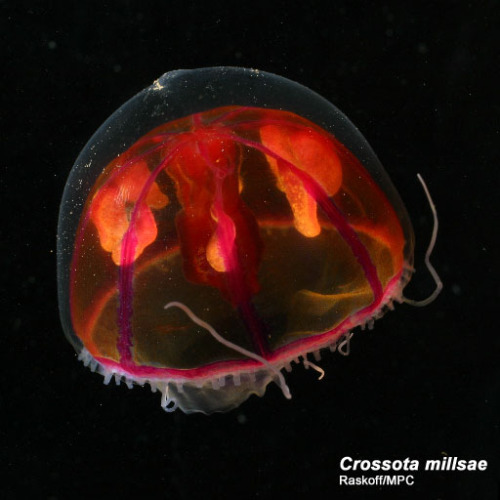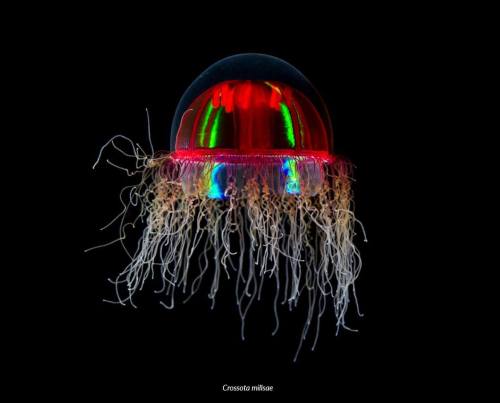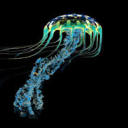Psychedelic Medusa


Psychedelic Medusa
Crossota millsae
The Psychedelic Medusa is a deep-sea hydrozoan that is abundant in the North Pacific. The mini-jelly is found at depths between 1000m to 3800m, and are often observed drifting near the ocean floor. It also has an eccentric reproduction behavior uncommon in cnidarians. The females display viviparity, and carry the babies in her bell until they are ready to hatch.
Photo credit: http://www.arcodiv.org/watercolumn/cnidarian/Crossota_millsae.html
https://twitter.com/spothvegr/status/1030177493075079169
More Posts from Bioluminescentoceangoddess and Others

Vampire Squid
Vampyroteuthis infernalis
Even though the Vampire Squid is named after a notorious monster, this gentle creature does not live up to its name. It is only a foot long and occupies depths between 650m to 1500m in the deep ocean. Unlike other squids, it has reduced musculature and collects particles in the water column. However, it is capable of huge bursts of speeds. It uses bioluminescence to confuse both predators.
Photo credit: https://ocean.si.edu/ocean-life/invertebrates/vampire-squid-hell


Piglet Squid
Helicocranchia pfefferi
The Piglet Squid is a very small and delicate, transparent squid. It is found at depths between 400 to 1000 m. It has an unique siphon that is used for jet propulsion and it resembles a pig muzzle. The young piglet squids tend to live close to the surface, and steadily migrates downward as they grow. This behavior is called ontogenetic migration.
Photo credit: http://photo.cctv.com/2019/07/23/PHOAKMEBh8xJRaHXEUIGx8kE190723.xml
https://www.ourbreathingplanet.com/banded-piglet-squid/





Wake up babe new fish dropped


Spookfish
Winteria telescopa
The Spookfish’s eyes act as a telescope and are designed to maximize light in the deep ocean. Its eyes contain rod cells that help distinguish between ambient light and bioluminescent light. This adaptation helps avoid predators and catch prey.
Picture Credit: https://www.natureplprints.com/deep-sea/deep-sea-fish-winteria-telescopa-15230734.html


Basket Star
Gorgonocephalus caputmedusae
The Basket Star is a strange yet elegant creature that lives in the deep ocean. It resembles a flesh white ball with gnarled and swirling branches. It thrives in locations with strong currents. Its numerous arms move slowly and wrap around prey. They are one of my favorite animals from the Echinodermata phylum.
Photo credit
https://link.springer.com/article/10.1007/s00227-005-0032-3
https://en.wikipedia.org/wiki/Gorgonocephalus


Lav Polyp
leuckartiara octona
The Lav Polypo is a jelly that comes in a variety of colors and shapes; it dwells about 200m in the deep ocean. The red mass inside its translucent bell is the jelly’s reproductive organs. Furthermore, it uses its dull, yellow tentacles can catch unsuspecting prey.
Photo credit: https://www.pinterest.com/pin/65935582019848580/
https://www.petjellyfish.co.uk/shop/live-jellyfish/leuckartiara-octona


Glowing sucker octopus
Stauroteuthis syrtensis
The Glowing Sucker Octopus can be found at 2500 m in the deep ocean. This unique creature has two fins that look similar to elephant ears. They move elegantly through the water by moving these fins and contracting their mantle. Evidence of this creature has only been spotted in the Atlantic Ocean.
Photo credit: https://octolab.tv/species/glowing-sucker-octopus/
https://ferrebeekeeper.wordpress.com/2011/03/14/glowing-sucker-octopus/

Scaly Dragonfish
Stomias Boa
The Scaly Dragonfish is about 32cm long and found at depths between 200 to 1500m. The long purple barbel on its chin is used to lure in prey. When the pery gets close enough, it swings its jaws forward swallowing the prey whole.
Photo credit: https://alchetron.com/Stomias
Video on the fish: https://www.youtube.com/watch?time_continue=69&v=9oB_61aI2iQ&feature=emb_title
Sea sparkle is a common, bioluminescent plankton. Even though its not an animal, it is worth sharing.


Sea sparkle
Noctiluca scintillans
Sea sparkle is a bioluminescent dinoflagellate that blooms in many coastal waters. Sea sparkle feeds on plankton, diatoms, fish eggs, and other dinoflagellates. It also has a flagellum, or tiny tail, that helps it move around in the water. Even though sea sparkle is beautiful to witness at night, it is hazardous to other marine species and resembles a reddish-pink film during the day.
Photo credit:
https://alexandrathemb.tumblr.com/post/49814932878/noctilucas-scintillans-a-bioluminescent
https://thevelv.blogspot.com/2015/07/noctiluca-scintillans.html


Jewel Squid
Histioteuthis heteropsis
The Jewel Squid is covered in color-changing photophores that resemble sparkling gem stones. They also have a light-red coloration and are about 20 cm in length. They display a unique behavioral adaptation called diel migration. During the day, they stay at depths around 400-1200 m, and then surface during night (0-400m). This behavioral pattern is designed maximize feeding at night, and avoid predators during the day. The primary predator of the Jewel Squid is the Sperm Whale.
Photo credit: https://www.pinterest.com/pin/722827808920240115/
https://twitter.com/theoctonation/status/1168516522270253056
-
 mawsteeth liked this · 2 years ago
mawsteeth liked this · 2 years ago -
 bigsmilenobitterness liked this · 2 years ago
bigsmilenobitterness liked this · 2 years ago -
 v3mpyre liked this · 2 years ago
v3mpyre liked this · 2 years ago -
 gravedangerahead liked this · 3 years ago
gravedangerahead liked this · 3 years ago -
 battlemage94 liked this · 3 years ago
battlemage94 liked this · 3 years ago -
 lost-in-the-shelves liked this · 3 years ago
lost-in-the-shelves liked this · 3 years ago -
 lystria liked this · 3 years ago
lystria liked this · 3 years ago -
 aeshnacyanea2000 reblogged this · 3 years ago
aeshnacyanea2000 reblogged this · 3 years ago -
 hydrozoaa reblogged this · 3 years ago
hydrozoaa reblogged this · 3 years ago -
 sleppybitch liked this · 3 years ago
sleppybitch liked this · 3 years ago -
 astrotracksuitbattalion liked this · 3 years ago
astrotracksuitbattalion liked this · 3 years ago -
 thetooconnoisseurlionlotusmystic reblogged this · 3 years ago
thetooconnoisseurlionlotusmystic reblogged this · 3 years ago -
 thetooconnoisseurlionlotusmystic liked this · 3 years ago
thetooconnoisseurlionlotusmystic liked this · 3 years ago -
 acolorcollective liked this · 3 years ago
acolorcollective liked this · 3 years ago -
 despair-with-walnuts liked this · 3 years ago
despair-with-walnuts liked this · 3 years ago -
 808beat liked this · 3 years ago
808beat liked this · 3 years ago -
 isitrebloggingtime reblogged this · 3 years ago
isitrebloggingtime reblogged this · 3 years ago -
 lady-blade liked this · 3 years ago
lady-blade liked this · 3 years ago -
 metam0rph3us liked this · 3 years ago
metam0rph3us liked this · 3 years ago -
 windyboysworld liked this · 3 years ago
windyboysworld liked this · 3 years ago -
 themoontoldme0 liked this · 3 years ago
themoontoldme0 liked this · 3 years ago -
 georgewalt liked this · 3 years ago
georgewalt liked this · 3 years ago -
 sundring liked this · 3 years ago
sundring liked this · 3 years ago -
 wildernesspete reblogged this · 3 years ago
wildernesspete reblogged this · 3 years ago -
 sasssholee liked this · 3 years ago
sasssholee liked this · 3 years ago -
 girl-like-substance liked this · 3 years ago
girl-like-substance liked this · 3 years ago -
 slothshark reblogged this · 3 years ago
slothshark reblogged this · 3 years ago -
 mr-crix liked this · 3 years ago
mr-crix liked this · 3 years ago -
 agent-plaguemask reblogged this · 3 years ago
agent-plaguemask reblogged this · 3 years ago -
 leitharstjarna liked this · 3 years ago
leitharstjarna liked this · 3 years ago -
 love-me-some-nice-moss liked this · 3 years ago
love-me-some-nice-moss liked this · 3 years ago -
 vaguelyexistingcloud liked this · 3 years ago
vaguelyexistingcloud liked this · 3 years ago -
 wizardsisananimal liked this · 3 years ago
wizardsisananimal liked this · 3 years ago -
 bookscatsandfandomsforever liked this · 3 years ago
bookscatsandfandomsforever liked this · 3 years ago -
 alter1412 reblogged this · 3 years ago
alter1412 reblogged this · 3 years ago -
 alter1412 liked this · 3 years ago
alter1412 liked this · 3 years ago -
 megakimathi liked this · 3 years ago
megakimathi liked this · 3 years ago -
 masteralaric liked this · 3 years ago
masteralaric liked this · 3 years ago -
 witchysolfan reblogged this · 3 years ago
witchysolfan reblogged this · 3 years ago

Bioluminescence is a chemical reaction that produces light. Many deep sea animals use bioluminescence. This blog is dedicated to educating the public about the amazing creatures that thrive in the deep sea.
57 posts